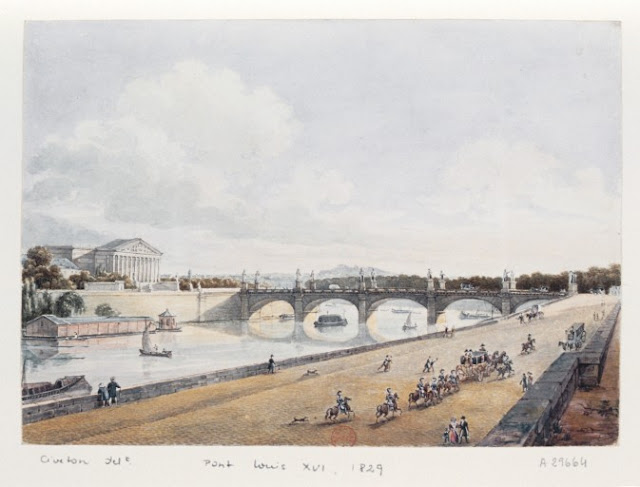 |
| The widened bridge 'de la Concorde' in Paris today |
Ce pont était en projet depuis 1725, lors de la construction de la place Louis XV (aujourd'hui place de la Concorde), pour remplacer le bac qui assurait alors la traversée à cet endroit.
Assurant la construction en pleine tourmente révolutionnaire, il utilise pour la maçonnerie des pierres de taille provenant de la démolition de la Bastille, prise d'assaut le 14 juillet 1789. La construction sera terminée en 1791.
En 1810, Napoléon Bonaparte y fit placer des statues en l'honneur de huit généraux morts au champ d'honneur pendant les campagnes du Premier Empire.
The architect Jean-Rodolphe Perronet, who in 1775 created (with Daniel Charles Trudaine) the "Royal School of Bridges and Roads" (now the "National School of Bridges and Roads") was responsible in 1787 for the design and construction of the new arched bridge.
A bridge had been planned since 1725, during the construction of the Place Louis XV (now the Place de la Concorde), replacing a former ferry crossing, then at this location.
Ensuring that the construction continued during revolutionary turmoil, Perronet used the stones and masonry from the demolition of the fortress of the Bastille, which had been stormed on 14 July 1789. Construction of the bridge was completed in 1791.
In 1810, Napoleon Bonaparte placed on it statues in honor of eight Generals killed in battle during the campaigns of the First Empire.
 |
| the pont Louis XVI on 1830, with the 12 colossal statues |
 |
| the pont Louis XVI in 1829, more-or-less the date of the statue by Claude Ramey père that is now located in the town of Richelieu in Touraine |
À la Restauration, on les remplaça par un ensemble de douze statues monumentales en marbre blanc de quatre grands ministres (Colbert, Richelieu, Suger, Sully), quatre militaires (Bayard, Condé, Du Guesclin, Turenne) et quatre marins (Duguay-Trouin, Duquesne, Suffren, Tourville). Mais cet ensemble est trop lourd pour le pont, et Louis-Philippe Ier fait enlever ces statues pour les transférer à Versailles.
At the Restoration, these eight were replaced by a set of twelve monumental white marble statues of four Ministers (Colbert, Richelieu, Suger, Sully), four soldiers (Bayard, Condé, Du Guesclin, Turenne) and four sailors (Duguay-Trouin, Duquesne, Suffren, Tourville). But all this was too heavy a load for the bridge's structure, and Louis-Philippe I removed the statues and transferred them to Versailles.
In 1932 the monumental statue of the cardinal duc de Richelieu was erected in his eponymous town in Poitou.
 |
| English description of the statue of Ramey père of 1830 |
These three pages are from the following book;
"Museum of painting and sculpture, or, Collection of the principal pictures, statues and bas-reliefs in the public and private galleries of Europe."
Author:
Etienne Achille Réveil (drawings); Jean Duchesne (text)
Publisher:
London, Bossange; Paris, Audot
1828
 |
| page 222 of "the Museum of painting and sculpture...." |
 |
| The inauguration of the statue in Richelieu town on 17 July 1932 |
CLICK HERE FOR THE SCULPTURE TODAY
 |
| the signature at the statue's base |
 |
| the statues in place |
 |
| Perronet's original concept drawing for the pont Louis XVI |
 |
| The statue itself, now in 37120 Richelieu |
***















No comments:
Post a Comment